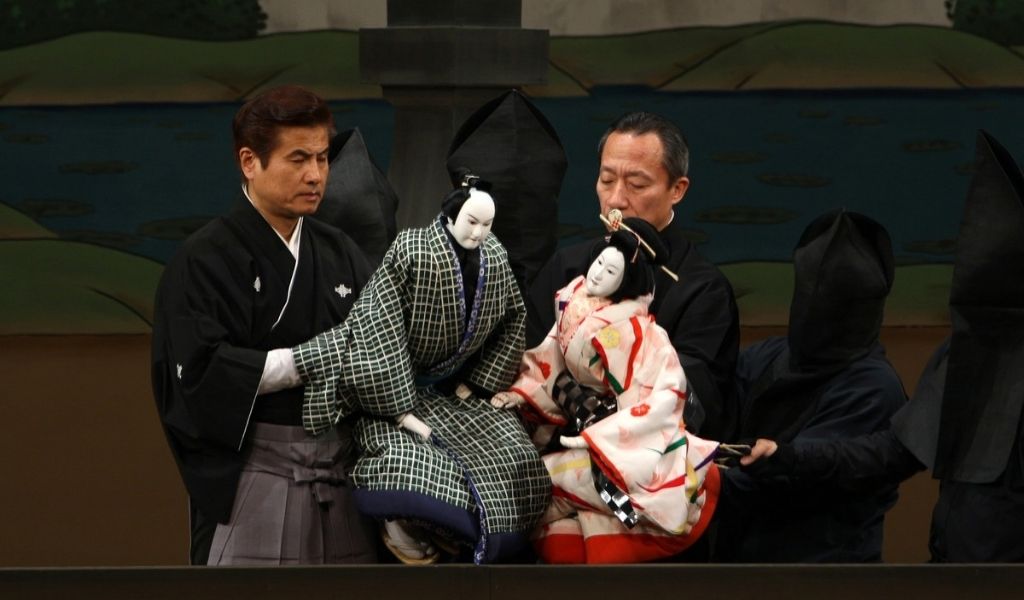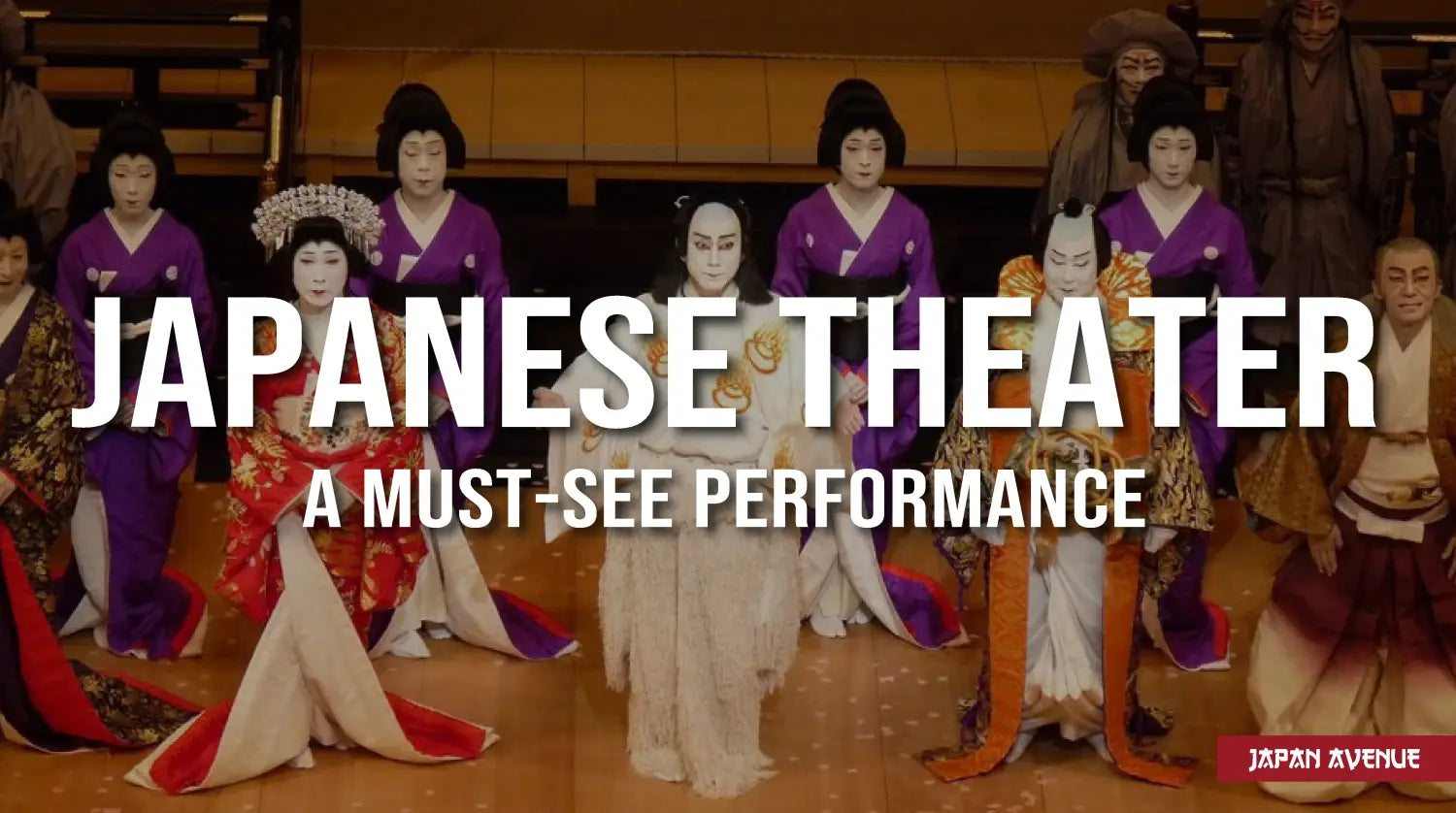Among the most spectacular Japanese arts, traditional Japanese theater is without a doubt at the forefront.
Japanese theater is a dance and song performance form, originating from religious rituals, local traditions, and popular entertainment. This scenic art, recognized as intangible cultural heritage by UNESCO, consists of several genres. The Kabuki, or popular form, the Noh or dramatic theater, the Kyogen in its comical version and the Bunraku or puppet show.
Let's have a closer look at this exceptional and traditional kind of entertainment, found in the Land of the Rising Sun.
🎭 Kabuki, popular Japanese theater
First appearing in the early 17th century, Kabuki is the traditional popular theater of Japan. This form of epic performance is very much appreciated in Japan since the Edo period and it gathers a large audience.

Nishizaki Sakurako and Bando Kotji in the Kabuki play "Yoshino Mountain"
The origins of Kabuki
The ideograms "ka" 歌, "bu" 舞 and "ki 伎" respectively means "song", "dance" and "technical skill". The very essence of Kabuki stems from the avant-garde spirit that characterized this art form at the time. Formerly, Kabuki actors were considered to be original, crazy people with a strange way of dressing (kabuki- mono).
In 1603, the famous dancer Okuni performed the first Kabuki show in Kyoto... an entertainment that quickly became popular. However, the plays were often performed by prostitutes and Kabuki was soon associated with debauchery. Confronted to this excess, the Tokugawa shogunate prohibited the presence of female artists on stage in 1629. Since then, the Kabuki acting profession has become exclusively reserved to men.
As the preferred theater of warriors, daimyos and the merchant bourgeoisie during the Edo period, Kabuki was distinguished by the costumes, the make-up and the completely extravagant acting style as well as by its spectacular staging.
Kabuki includes dance, comedy, romance and tragedy, all accompanied by a unique soundtrack. The shamisen, a traditional Japanese three-stringed instrument, expresses the emotions of the actors and reinforces their artistic performance. The stage is also equipped with many devices allowing remarkable visual effects (central turntable, machinery and footbridge crossing the audience).
Kabuki in modern times
Nowadays, this theatrical form keeps its original codes while at the same time renewing itself. As a result, icons of pop culture can be among the actors in order to touch young generations.
🙏 Japanese Noh drama theater
Noh is the dramatic form of traditional theater, consisting of lyrical songs, dances and mimes. A theater reserved for the Japanese elite since the era of the shoguns, Noh represents a unique art form that is both poetic and spiritual.

Performance of the Noh play "Aoi no Ue" or "Lady Aoi".
The origins of Noh theater
Born in the 14th century during the Muromachi period, Nôgaku is the oldest form of theater, at the origin of Nô (lyrical drama) and Kyogen (comedy). It appeared before Shakespeare's works and is derived from Sangaku, a popular circus genre dating back to the 8th century.
Noh has its roots in religious cults and ritual dances practiced in the past to appease the kami and to bless the crops of the farmers (Kagura). Later on, Sangaku will add a more spectacular dimension by integrating magic numbers, acrobatics and a comic aspect. Little by little, the search for aesthetics overtook the sacred character, offering true artistic performances. Moreover, "Noh" means "power" and becomes "talent" to salute the work of the artists.
During the Muromachi period, Noh introduced new codes regulating costumes, masks, songs and the orchestra. Although the spirit of Sangaku was preserved, Noh was henceforth addressed to the warrior aristocracy.
The Noh actors
Noh actors practice from generation to generation. They are always men. The shite is the main actor and remains the main thread of the plot. Dressed in an elegant kimono, he performs the slow dance called Kuse. The waki is the secondary character that helps the viewers to understand the context of the story. Unlike the shite, he never wears a mask.
The actors play different characters such as men, women, old men, souls or kami, using many different No masks, called Nômen. The main actor most often plays a ghost. Note that at the time, life expectancy was much shorter than today and death was very much on people's minds.
The Nômen masks
Japanese masks date back to prehistoric times (Jomon period) and have been used for centuries and still remain very popular during Shinto festivals. The Noh theater masks are impregnated with this ancestral culture. Handcrafted, Noh masks are carved out of a piece of wood and then painted. They feature characters grouped in several categories: men, women, old people and demons. As a result, the actors can embody just about any protagonist.

Examples of wooden Noh masks.
Noh theater of today
Since its inception, Noh has remained intact and represents the local traditional culture through classical literature, Japanese legends as well as through masks, costumes and kimonos. Due to its lyrical aspect, foreigners refer to it as Japanese Opera.
🤣 Kyogen, Japanese comic theater
Kyogen theater represents the comical wing of Noh. This satirical art came from China in the 8th century and was called Sarugaku, which literally means "monkey theater". It developed in Japan by integrating the cultural beliefs of the medieval period. Thus, demons and kamis were played regularly. Moreover, the language used in the dialogues originates from the Muromachi period.
Only in the 14th century, Kyogen theater became codified and adopted the characteristics we are familiar with today: medieval costumes, typical masks, and stylized gestures, under the influence of the famous Japanese playwright Zeami.

Kyogen theater group, Shigeyama Sengoro.
Kyogen is distinguished from other theatrical forms by its short and rhythmic plays which are inspired by the defects of Man to cause laughter in the audience. Its name composed of the ideograms "kyo" 狂 and "gen" 言, means "foolish words". Following the example of Shakespeare and Molière, the themes of the plays turn around everyday worries or even Man's place in the universe.
Noh Theater pranks
Light and comical, the kyogen is perfectly complementary to the serious and dramatic Noh theater. Moreover, the scenes of the Noh are often interspersed with Kyogen in the interlude, in order to release the tension a little. The scene lasts about 20 minutes and is intended to relax the audience.
The pieces that are interspersed between two acts are called hon-kyōgen and those that intersperse two Noh scenes are called ai-kyogen. They provide details about the performance and give the actors time to change costumes.
👏 Bunraku, Japanese puppet theater
Halfway between Noh and Kabuki, Bunraku is a form of traditional Japanese theater from the dramatic repertoire that combines puppets, sung stories and instrumental accompaniment.

Bunraku theater performance at the National Bunraku Theatre, in Osaka, Kyoto.
Origin of Bunraku
Bunraku was founded in the 17th century during the Edo period, combining the musical narrative style "jōruri" with puppet theater. This unique performance form developed in the 18th century with its characteristic puppet play before becoming known as Ningyo Johruri Bunraku in the 19th century. Themes are inspired by medieval dramas and contemporary representations of the duality between love and social duty.
The art of Bunraku
Bunraku puppets are carefully made by master puppet makers. Each puppet has its own facial expression and is dressed in a traditional costume.
The puppets are articulated by three puppeteers dressed in black, who are only visible from the waist up. They come to life thanks to the play of the artists who are perfectly coordinated to obtain fluid gestures. The first one articulates the face, the body and the right arm of the puppet. Generally, this role is occupied by the most experienced artist. The second performer moves the left arm of the puppet while the third performer controls the legs. The stories are sung by a narrator accompanied by a shamisen player. In addition, the storyteller modulates his voice and intonations according to the character he embodies.
🤩 Japanese theater nowadays
Japanese theater today remains an emblematic aspect of traditional Japanese culture. Both poetic and aesthetic, stage performances of actors are absolutely remarkable. As you may have understood, this very typical art of theater is a true must see if you happen to go to Japan!



